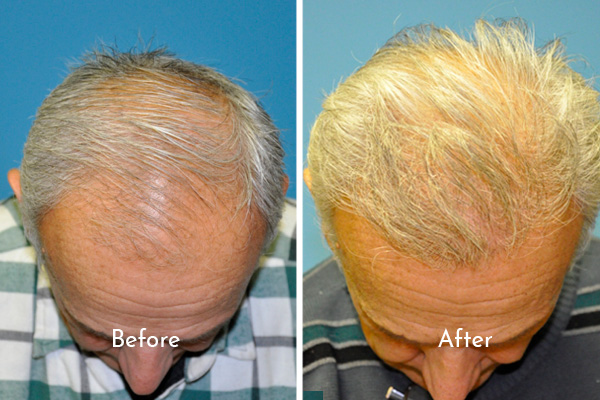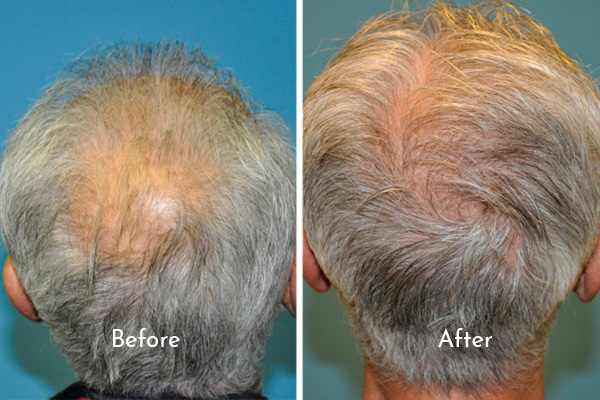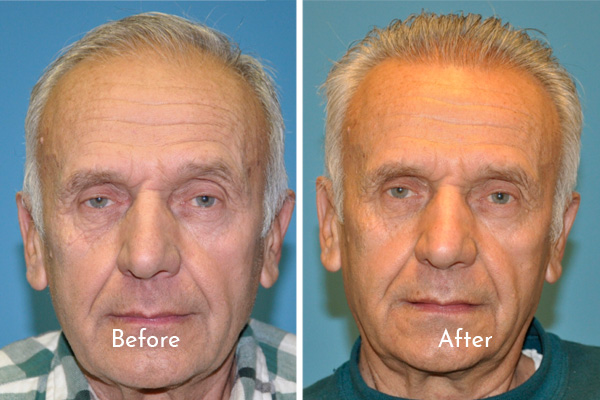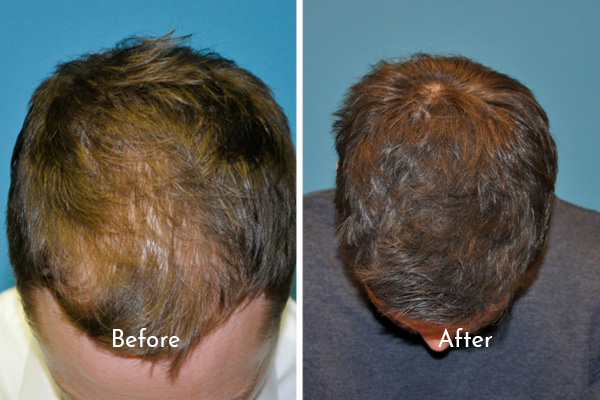Hair Restoration
Genetically predisposed hair loss is an issue that commonly affects both men and women. Hair loss can have a big impact on the appearance of a person, leading to a loss of self-esteem and confidence. Although we still have a lot to learn about the most common causes of hair loss, treatment methods are available to improve the hairline and to repair male and female-pattern baldness.This is an information session that Dr. Barr did with Studio 5 where she offers some general information about hair restoration and addresses some common questions about hair restoration procedures. Below, you can find additional information about hair loss and various options that are available for treating the condition.

Male Hair Loss
Male-pattern baldness, also known as androgenic alopecia, becomes more common in men as they age. Hair loss can begin as early as the teen years and is experience by at least half of men by the time they are 50. The rate of loss following the onset is variable, however, is typically progressive. The ultimate extent of hair loss can be estimated by a variety of factors including family history. The staging of hair loss is most commonly classified by the Norwood staging system.
Genetics: Your family history is extremely important in predicting your future hair loss. Alopecia is thought to be polygenic meaning that it can be passed on from either your mother or father’s side of the family.
DHT: Testosterone is converted to DHT (dihydrotestosterone) by an enzyme called 5 alpha reductase. Hair follicles that are overexposed to DHT will have a progressively shorter growing phase and a decrease in dermal papilla volume leading to progressively shorter and finer hair shafts.
Other Factors: Although androgenic alopecia is the most common type of hair loss in men, other causes such as autoimmune disease, infection, scarring, environmental factors, illness and medications can lead to different types of hair loss, some of which may be treatable.
Gallery




Gallery

Female Hair Loss
At least 1 in 5 women will develop significant hair loss, the causes of which are varied. While in males, the role that androgens play in hair loss is clear, the role they play in women with hair loss is not completely understood. In women, the aromatase enzyme converts testosterone to estradiol. Interestingly, aromatase inhibitors seem to increase female pattern alopecia.
Female pattern hair loss is different than seen in males, often with the frontal hairline remaining intact, and a general thinning of the rest of the hair. The Ludwig classification scale is often used to diagnose the degree of hair loss. This type of hair loss usually begins either in the late 20s or in the 50s, and can have a devastating effect on a woman’s self-esteem and emotional well-being.
Women are at a higher risk for experiencing a condition called telogen effluvium, or shedding of hair as a result of a medical condition such as iron deficiency or thyroid disease, which is why it’s essential that a proper diagnosis be established prior to proceeding with treatment.
Treatment Options
Dr. Barr will develop an individualized treatment plan based on the extent of your hair loss, your age, your family history and your goals.

Non Surgical Treatment Options
Medical Treatments: There are currently two medications approved by the FDA for hair restoration: Propecia and Rogaine. Propecia (Finasteride) blocks the conversion of testosterone to DHT which stabilizes the hair follicles susceptible to DHT and even allowing for re-growth of miniaturized hairs for men with hair loss. Rogaine (Minoxidil) is a topical application that stabilizes hair follicles and we recommend that men use the 5% formulation every night. Minoxidil 2% can also be used in women and is currently the standard medical treatment for female pattern hair loss. Other medications such as spironolactone and ketoconazole while not FDA approved specifically for hair loss may also be effective. Dr. Barr will recommend their use if she feels they are appropriate.
Ducray: We also offer Ducray hair care products that help you maintain a healthy scalp and strong, full hair. From dietary supplements to topical treatments, Ducray offers a wide range of scientifically formulated products suitable for any hair type.
Devices: Low-level light therapy (LLLT) devices have been marketed for hair growth. The Hairmax Lasercomb has FDA approval. More studies are necessary to support the role LLT should play in treating hair loss.
Other vitamins, supplements, and products: Many other products are marketed and claim to re-grow hair however due to the lack of scientific support, we do not routinely recommend them. Dr. Barr can further discuss these products at your consultation.

Surgical Treatment Options
Hair transplant surgery is performed in the office under a local anesthetic by a team of experts. The duration of the surgery will vary based on the number of grafts you decide to have transplanted.
FUT: Follicular unit transplantation is often referred to as the “strip technique.” This technique uses follicles from a strip of scalp harvested from the back of your head, where genetic hair loss patterns don’t cause hair loss. The unaffected follicles are isolated and transplanted into areas of the scalp where hair loss is occurring. The area where the strip was removed will have a narrow linear scar that can be easily camouflaged by surrounding hair as long as you don’t plan to wear your hair ‘high and tight.’
FUE: Follicular unit extraction is a process where hair follicles are individually harvested from the back and sides of the scalp. Dr. Barr uses the powered S.A.F.E. scribe system which allows her to efficiently extract healthy individual follicles. These follicles are then implanted into the desired areas, typically the front and top of the scalp. This technique is ideal for men who prefer to wear the back of their hair very short as it does not create a linear scar. The scattered individual harvest scars are less than 1mm and are very difficult to detect even with the hair extremely short.

Eye Brow Restoration
Eye Brow hair transplant is a surgical procedure intended to permanently restore hair to eye brows that are too thin, scarred or completely missing. The ideal brow shape is used to design the hair transplant site. Hair follicles are then harvested from the scalp and inserted into the area of the created brow.

Hair Transplant for Scar Camouflage
Loss of hair-bearing tissue in the head and neck area can result from surgery, trauma, burns, tumors, and infection. The resulting defect can be cosmetically disfiguring. Dr. Barr can use hair grafting from your scalp to help camouflage the scarring and restore a more natural appearance. Dr. Barr published an article on the use of hair grafting in scar camouflage in the Facial Plastic Surgery Clinics of North America.
Recovery
You will go home immediately following your surgery and should plan to take it easy for a couple of weeks. Detailed instructions will be provided by Dr. Barr to care for the grafts. The scabs will take approximately 2 weeks to fall off. The transplanted and some surrounding hair will temporarily shed and you will see the hair really start to grow in around 6 months after surgery. Hair then grows at 1/2 inch per month. Dr. Barr will follow up with you regularly during the year following your surgery.
Dr. Barr will recommend and customize a number of grafts based on your scalp hair loss pattern and family history.






